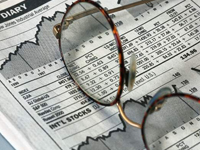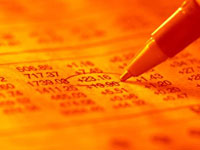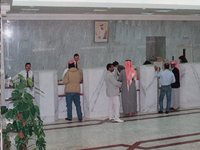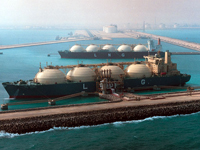|
 |
The
Qatari economy has evolved rapidly over the past few years from
a primarily oil based economy to one that increasingly includes
other hydrocarbon products such as liquefied natural gas (LNG),
condensate, propane, butane and other natural gas liquids. The
government’s current economic diversification policy emphasizes
the optimal utilization of Qatar’s large reserves of natural gas
for downstream industries and/or as feedstock and also to
further attract
in the non-oil sectors of the economy. The resulting economic
windfalls from the gas sector have already started filtering
into the economy and have enabled Qatar to stand with one of the
highest per capita incomes in the world.
With the economy of Qatar experiencing a very rapid growth,
the Ministry of Economy and Trade has set goals and policies
that will lead Qatar into a prosperous future. |
|
The Goal of Qatar’s Economic Policy |
| To achieve sustainable economic growth in partnership with
the private sector. |
|
Strength of Qatar’s Economy |
|
|
|
Economic Policy Objectives |
-
To promote economic growth
- To
increase the economy’s resilience and competitiveness
- To
diversify the economy
- To
create the right investment climate
- To
strengthen the private sector and increase its role in
the economy
- To
become part of the Global economy
|
|
Economic Policies |
-
Liberalization of the economy
-
Liberalization of trade and integration in the global
economy.
|
|
Gross
Domestic Product (GDP) |
|
The Qatari economy underwent major developments that were
positively reflected on the general economic performance.
Foremost among these developments are the upsurge in oil prices
that gained Qatar high revenues, the sizable increase in gas
production and exports and the completion of the giant gas
projects of the country. The Gross Domestic Product (GDP)
was set at about QR70.8 billion in 2003 against QR.63.6 billion
in 2002, growing by 8.8% in 2003 against 0.8% in 2002. This
improvement is attributed to the increase of 12.9% in GDP
in 2003 compared to 1.9% in 2002 at oil and gas sector, in
addition to a 3.2% growth rate at non-oil sectors against
0.6% decline in 2002. |
|
Public
Finance |
 |
The
state budget plays a vital role in the Qatari economy,
as public expenditure represents a large share of the
total effective demand, which is the main factor in
achieving the Government’s economic development goals.
Fiscal policy is considered the core of the overall
economic policy, which aims to achieve full utilization
of economic resources and to raise standards of living
in Qatar. Qatar’s strengthening fiscal position has
already lead to sovereign ratings upgrades.In July
2003,Standard & |
|
Poor’s (S&P) upgraded Qatar’s long-term foreign currency
issuer credit and senior unsecured debt ratings from A-
to A+. Qatar’s long-term local currency issuer credit
ratings were also upgraded from A to A+. Qatar’s
short-term foreign and local currency issuer credit
ratings were maintained at A-1. In August 2002, Moody’s
Investors Service raised by two notches Qatar’s foreign
currency country ceilings for bonds and deposits to A3
from Baa2. Moody’s also upgraded to A3 the ratings of
the State of Qatar’s outstanding foreign-currency
denominated bonds and its issuer rating for local
currency obligations. In September 2002, Capital
Intelligence announced that it had raised Qatar’s
sovereign long-term rating to A- from BBB+.
The announced 2004/05 State
Budget by the Ministry of Finance, revealed another fiscal
year of expansion, which will also act as a catalyst in boosting
private sector activities. Budget allocations for major public
projects increased by 44.3% to reach QR 8,883 million, compared
to QR 6,154 million in the previous budget. The budget estimates
total revenues at QR 26,192 million, total expenditures at
QR 28,352 million, with an overall deficit of QR 2,160 million.
Total revenues are budgeted to increase by 21.3% over the
preceding budget and total expenditures are budgeted to increase
by 21.6%. The 2004/05 Budget is reportedly
based on an oil price assumption of $19.0 p/b, compared to
$17.0 p/b in the previous budget estimates. Given an increase
of $1 p/b, at a production level of 700,000 bpd, additional
export revenues of about QR 900 million would be realised.
Therefore, a balanced budget would occur if oil prices averaged
$21.5 p/b during the fiscal year 2004/05.
Details of 2004/05 Budget Allocations: |
|
a. Public Services and
Infrastructure |
-
QR
1,869 million for roads and transportation.
-
QR
1,300 million for land acquisition & reform.
-
QR
661 million for sewage works.
-
QR
500 million for water and electricity.
-
QR
188 million for the development of new light
and medium industrial area.
-
QR
300 million for other projects
Sub Total: 4,266 4,818 12.9
|
|
b. Social and Health
Care |
-
QR
333 million for constructing 2,200 family houses
and complete ongoing construction.
-
QR 1,542 million for community services.
-
QR 591 million for the Hamad Medical
City project, completing hospital in the south, building
new health centres, and expansion of Shamal Hospital,
Hamad General Hospital and Rumailah Hospital.
Sub Total: 927 2,466 166.0
|
|
c. Education and Youth
Welfare |
- QR
1,599 million for building and completing ongoing construction
of schools, improve existing facilities of schools and
University buildings, and the construction of youth and
sports facilities.
Sub Total: 961 1,599 66.4
Total 6,154 8,883 44.3
(Source: Ministry of Finance)
A
statement from the Ministry of Finance alongside the 2004/05
Budget mentioned that the fiscal plan was drawn up for
attaining the sustainable and omprehensive development
of the State, by the provision of financial resources
to achieve the following:
-
Head Forward to minimize the difference between public
spending and public revenues.
-
Economic growth of around 5%, with an cceptable level
of inflation.
-
Expansion in the implementation of major projects for
community development and infrastructure
|
|
Monetary Policy |
|
The monetary management in Qatar is implemented by Qatar Central
Bank (QCB) which was established by Law No. 15 for the year
1993, from what was formerly called the Qatar Monetary Agency
(QMA). The main objective of the QCB is to regulate the monetary,
credit and banking policies in accordance with the general
plans of the State, in order to support the national economy
and the stability of the currency. QCB has full powers over
the monetary policies of the State, and supervises and controls
banks and financial institutions. An effective monetary tool
utilized by the QCB is the imposition of minimum reserve requirements
for commercial banks. In February 2000, QCB instructed banks
to maintain cash reserves equal to 2.75% of total deposits.
Another important tool used by the QCB is the loans-to-deposit
ratio limit applied to commercial banks, which is set at 95%
of the total
deposits base. |
|
Domestic Liquidity |
|
Two broad trends have dominated liquidity in Qatar: first,
credit to the public sector to finance development projects
and second, the price of energy. During the first half of
2003, domestic liquidity as measured by M2 rose by 7.7%, with
a significant increase in demand deposits by 87.9%. Savings
and time deposits declined by 11.4% during the first half
of 2003. |
|
Exchange Rate Policy |
|
 |
|
The Qatari Riyal is officially pegged to the US dollar at
a rate of 1 US$ = 3.65. |
|
|
Interest Rate policy |
|
In February 2001, the QCB removed its ceiling on interest
rates for local currency deposits, freeing the banking system
from all interest rate policy restrictions. In July 2001,
the QCB introduced a new monetary instrument called the ÒQatar
Monetary RateÓ (QMR), which allows banks in Qatar to
deposit or borrow from the QCB, overnight funds of an amount
not less than QR 2.0 million, at rates determined by the QCB,
which are fixed on a daily basis. Short-term interest rates
in Qatar follow closely those prevailing in the US, with a
slight positive differential. |
|
The Oil Sector |
|
Qatar’s main oil operations are carried out by state-owned
Qatar Petroleum (QP)
www.qp.com,
which manages Qatar’s oil, gas petrochemicals and refining
enterprises in Qatar and abroad. Qatar’s total oil exploration
area is divided into 18 blocks covering a total surface area
of 46,840 square kilometers.
The Government's oil policy has the twin aims of replenishing
proven reserves within currently producing fields and identifying
additional new reserves. Qatar’s oil reserves at year
end 2002 stood at 15.2 billion barrels, which represents 1.4%
of the world’s total reserves. Qatar’s oil reserves
have substantially risen over the past years, from 3.7 billion
barrels in 1998 to 15.2 billion barrels in 2002.
QP has embarked upon an investment programme with the intention
of expanding oil production capacity from its onshore and
offshore fields to around 1 million bpd by year-end 2006.
QP produces oil on its own account from one unit onshore and
two offshore fields and from other fields through Exploration/Development
and Production Sharing Agreements (EPSAs/DPSAs) with major
international partners such as, Occidental Petroleum, Maersk
Oil, TotalFinaElf Qatar and Anadarko Petroleum. |
|
Oil Production, Price
and Exports |
|
Qatar’s oil production averaged 730,000 bpd in the second
quarter of 2003, compared with 740,000 bpd in the first quarter
of 2003, according to the Middle East Economic Survey (MEES).
Qatar’s oil price averaged $25.5 p/b during the second
quarter of 2003, compared with $29.8 p/b during the first
quarter of 2003. Qatar’s oil prices are based on the
average of a basket of two crudes (Dukhan and Marine), which
amounted to $27.1 p/b in 2000, $23.6 p/b in 2001, and
$24.5 p/b in 2002. |
|
The
Natural Gas Sector |
|
Qatar’s North Gas Field, discovered in 1971, is the
largest nonassociated gas field in the world, with proven
reserves currently estimated at over 900 trillion cubic feet
(tcf), which is equivalent to about 162 billion barrels of
oil. These reserves would translate into 15.3% of the world
total and will be sufficient to support planned production
of natural gas for over 200 years. |
|
Qatar LNG Projects |
|
QP has initiated and developed two major LNG projects with
foreign shareholders for the purpose of utilizing the North
Field gas for exports in the form of LNG. These projects are
Qatargas and Rasgas.
Expansion of LNG facilities through RasGas II, Qatargas II,
and Qatargas III is being pursued to meet additional export
opportunities. Sales and Purchase Agreements (SPA) have been
reached with a number of countries, which at their peak in
2009 will reach 27.7 million tons per annum (mtpa). With planned
expansion projects in the LNG, total LNG exports would reach
about 51 mtpa by 2010. |
|
Key partners with QP in
developing this industry |
- Qatargas
TotalFinaElf 20%, ExxonMobil 10%, Mitsui 2.5% and Marubeni
2.5%
-
Qatargas II ExxonMobil 30%
- Qatargas
III ConocoPhillips 30%
- RasGas
ExxonMobil 25%, Koras 5%, Itochu Corp. 4% and LNG Japan
3%
-
RasGas II ExxonMobil 30%
|
|
Other Natural Gas Projects |
-
Dolphin Project, This is the first export pipeline project
in the GCC region to provide dry gas to UAE and possibly
to Oman. This project will be the basis for a GCC gas
grid. Partners are UOG 51%, Total FinaElf 24.5%, Occidental
24.5%. Expected capacity 2.0 bn cf/d of gas.
-
Khaleej Gas Project (1.75 bncf/d)
ExxonMobil Middle East Gas Marketing Ltd. will handle
this new upstream gas development with power generation
(Ras Laffan IWPP) being the initial major user. Expected
capacity 1.7 bn cf/d of gas.
|
|
Natural Gas Liquids |
 |
This represents liquids recovered from the processing of natural
gas and from stripping offshore and onshore crude oil at the
four existing facilities. NGL-1, NGL-2, NGL-3, NGL-4. |
|
Gas to Liquid Projects
(GTL) |
|
|
QP continues to research other avenues for the utilization
of the Country’s natural gas resources. Technologies
for the direct conversion of natural gas into globally marketable
and more easily transportable liquid products have evolved
significantly in recent years and are of particular interest
as a potential adjunct to direct exports of LNG and natural
gas. Qatar's six projects which are at different levels of
completion and/or negotiations will be responsible for the
export of the following quantities:
-
Oryx GTL Project (SASOL) 34,000 bpd
-
ExxonMobil GTL 80,000 bpd
-
Shell GTL 140,000 bpd
Other GTL Projects:
-
ConocoPhillips
50,000 bpd
-
Marathon
Oil Co. 100,000 bpd
-
Sasol/Chevron
80,000 bpd
|
|
Gas Based and Other
Industrial Projects |
- Qatar
Fertiliser Company (QAFCO) Ð Norsk Hydro (25%)
-
Qatar Fertiliser Company 4 (QAFCO 4)
-
Qatar Fuel Additives Company (QAFAC) Ð OPIC (20%),
LCY(15%), International Octane Ltd. (15%)
- Qatar
Petrochemical Company (QAPCO) Ð Atofina (20%)
- Qatar
Vinyl Company (QVC) Ð Norsk Hydro (29%), Atofina (12.9%)
|
|
Other Industrial Sectors |
|
In addition to its roles as the basis for the LNG industry,
and as a fuel input for power generation, natural gas is used
in a wide range of industries as feedstock to produce various
value-added products for both domestic consumption and exports.
These projects among others include:
- Qatar
petrochemical Company (QAPCO)
- Qatar
Vinyl Company (QVC)
- Qatar
Chemical Company (Q-Chem)
- Qatar
Fertilisers Company (QAFCO)
- Qatar
Fuel Additives Company (QAFAC)
|
| |
|
|